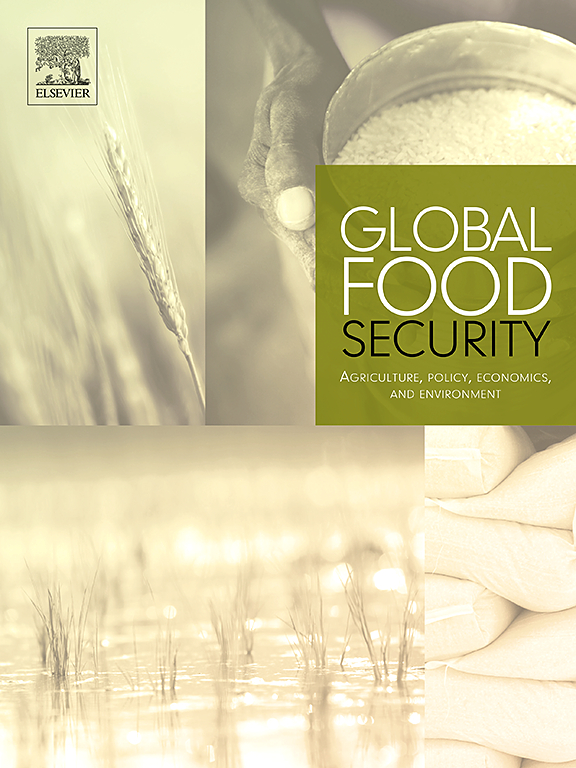在印度农村无组织的零售环境中,水果和蔬菜购买财政激励计划的意外后果
IF 9.6
1区 经济学
Q1 FOOD SCIENCE & TECHNOLOGY
Global Food Security-Agriculture Policy Economics and Environment
Pub Date : 2025-06-17
DOI:10.1016/j.gfs.2025.100869
引用次数: 0
摘要
印度农村的水果和蔬菜消费量是世界上最低的。我们评估了财政激励计划如何影响印度农村无组织零售环境中水果和蔬菜的购买,并探讨了任何意想不到的后果。我们采用了混合方法,对社区成员、供应商、当地领导和干预措施实施者的深度访谈(N = 21)、水果和蔬菜采购调查(N = 1109)、供应商销售调查(N = 36)和常规优惠券使用数据进行三角测量。这一干预措施促使家庭使用自己的预算购买水果和蔬菜,并获得现金返还。这些钱被用来购买更多的水果和蔬菜(分别占干预参与者的45%和77%)。购买行为的变化意外地增加了农村市场上农民对消费者的销售。这增加了当地购买的水果和蔬菜的种类(干预村与对照村的基线调整后的平均差异为2.2种(95% CI: - 0.7至5.1)),但可能对现有供应商的销售产生负面影响(干预村与对照村的基线调整后的平均差异为- 150卢比(95% CI: - 296至- 0.1)。财政激励计划有可能改变无组织零售环境中的食品环境,这可能对饮食产生重大影响。本文章由计算机程序翻译,如有差异,请以英文原文为准。
Unintended consequences of a financial incentive scheme for fruit and vegetable purchasing in an unorganised retail setting in rural India
Consumption of fruits and vegetables in rural India is among the lowest in the world. We assessed how a financial incentive scheme influenced purchasing of fruits and vegetables in an unorganised retail setting in rural India and explored any unintended consequences. We used a mixed-methods approach, triangulating between in-depth interviews with community members, vendors, local leaders, and intervention implementors (N = 21) and fruit and vegetable purchasing surveys (N = 1109), vendor sales surveys (N = 36), and routine coupon use data. The intervention led households to use their own budgets to buy fruits and vegetables and receive the cashback. This was used to buy more fruits and vegetables (45 % and 77 % of intervention participants, respectively). Changes in purchasing behaviours unexpectedly increased farmer-to-consumer sales in the village markets. This increased the variety of fruit and vegetables purchased locally (baseline-adjusted mean difference of 2.2 items in intervention versus control villages (95 % CI: −0.7 to 5.1)) but may have negatively impacted the sales of existing vendors (baseline-adjusted mean difference of −150₹ in intervention versus control villages (95 % CI: −296 to −0.1). Financial incentive schemes have the potential to change the food environment in unorganised retail settings, which could have major consequences for diets.
求助全文
通过发布文献求助,成功后即可免费获取论文全文。
去求助
来源期刊

Global Food Security-Agriculture Policy Economics and Environment
FOOD SCIENCE & TECHNOLOGY-
CiteScore
20.90
自引率
3.40%
发文量
69
期刊介绍:
Global Food Security plays a vital role in addressing food security challenges from local to global levels. To secure food systems, it emphasizes multifaceted actions considering technological, biophysical, institutional, economic, social, and political factors. The goal is to foster food systems that meet nutritional needs, preserve the environment, support livelihoods, tackle climate change, and diminish inequalities. This journal serves as a platform for researchers, policymakers, and practitioners to access and engage with recent, diverse research and perspectives on achieving sustainable food security globally. It aspires to be an internationally recognized resource presenting cutting-edge insights in an accessible manner to a broad audience.
 求助内容:
求助内容: 应助结果提醒方式:
应助结果提醒方式:


